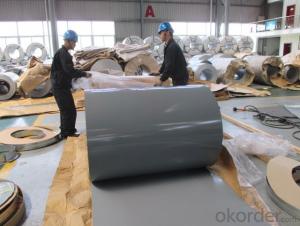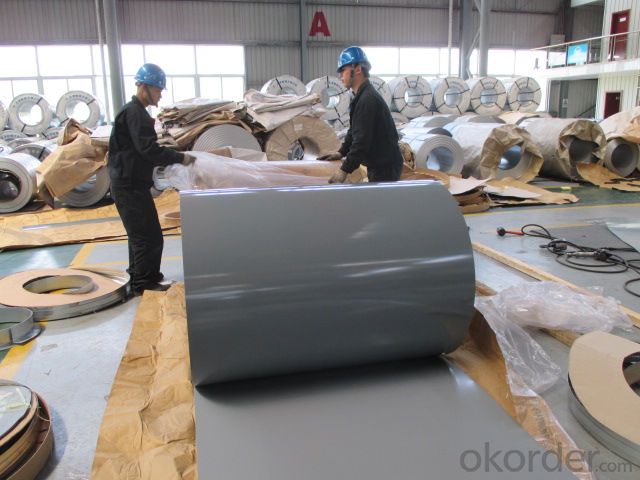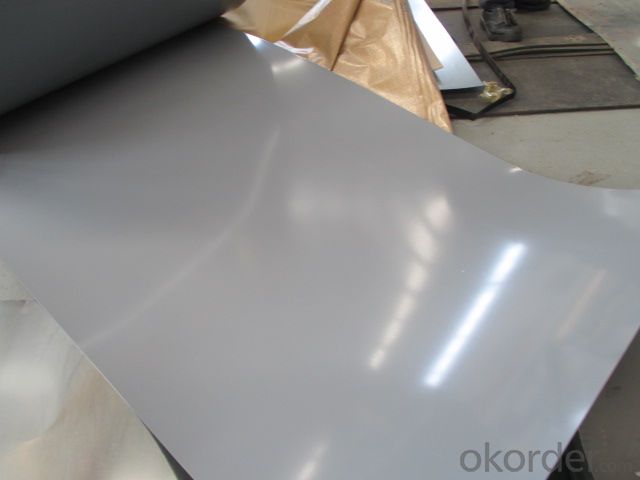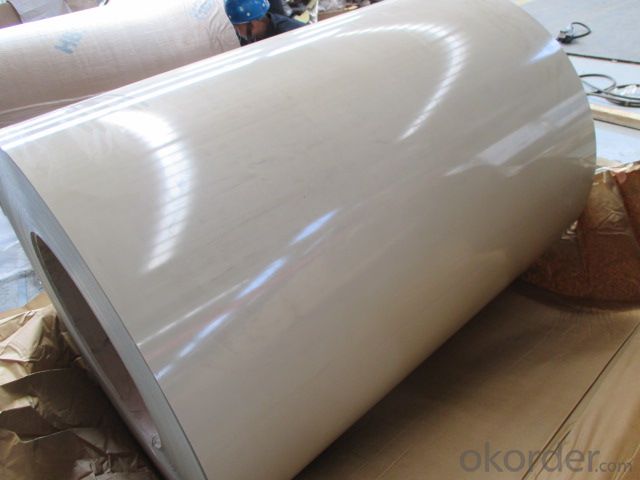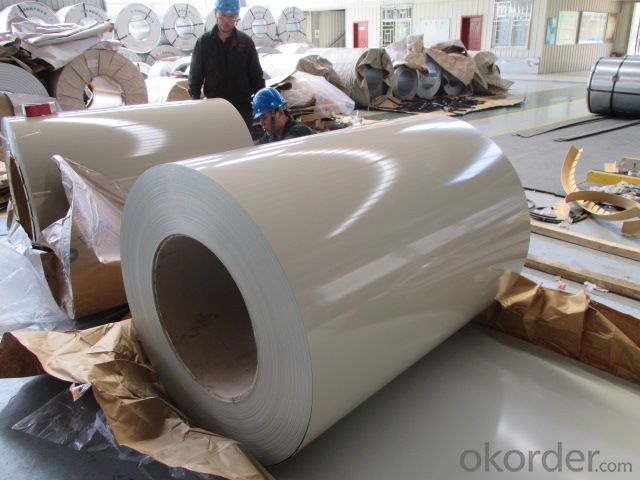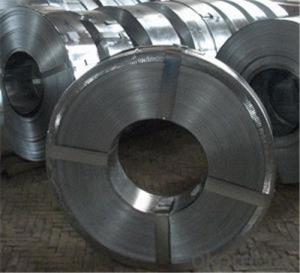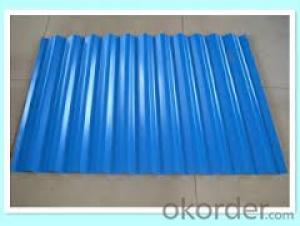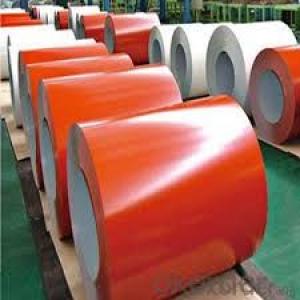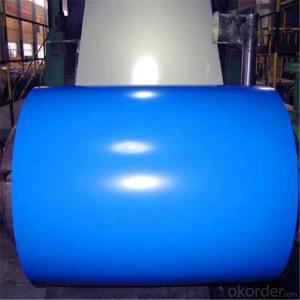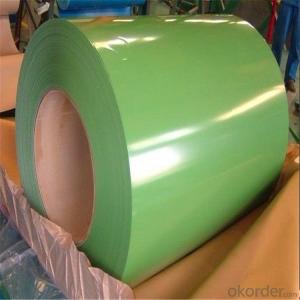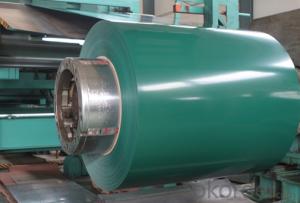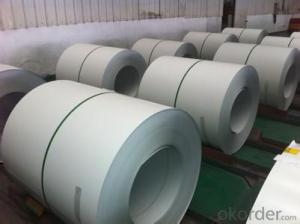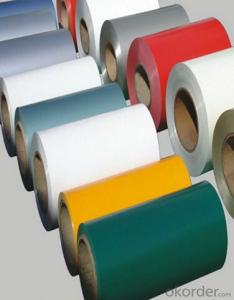0.22*1200mm prepainted galvanized color coated PPGI steel
- Loading Port:
- Shanghai
- Payment Terms:
- TT OR LC
- Min Order Qty:
- 10 m.t.
- Supply Capability:
- 100000 m.t./month
OKorder Service Pledge
OKorder Financial Service
You Might Also Like
Specification
Base metal | Hot dipped galvalume steel |
Thickness | 0.15mm-1.2mm |
Width | 700mm-1250mm |
Coil ID | 508mm / 610mm |
Layers of the coating | 2/2(2 layers of top coating/2 layers of bottom coating); 2/1(2 layers of the top coating, 1 layer of bottom coating); 1/1(single layer of top coating/ single layer) |
Color | According to customers’ request |
Paint | PE / PVDF |
Thickness of the coating | 15um-25um |
AZ coated | 50g/m2-275g/m2 |
Surface | Film coverd |
Package | Waterproof paper + polyethylene rush inhibitor,the antirust paper , the ring of defendse on inside and outside, steel belt, and the guard plate.
We can also pack according to your request details. |
- Q: Can steel coils be used in the production of medical equipment?
- Yes, steel coils can be used in the production of medical equipment. Steel is a versatile material known for its strength, durability, and ability to withstand various environmental conditions. It is commonly used in the manufacturing of medical equipment such as surgical instruments, orthopedic implants, hospital beds, and diagnostic machines. Steel coils are often utilized as a raw material in the production process. They can be processed and formed into various shapes, sizes, and components required for medical equipment. The coils can be cut, shaped, and welded to create intricate parts with precise specifications, ensuring the quality and performance of the final product. Moreover, steel coils can be surface-treated to enhance their corrosion resistance, making them suitable for use in medical environments where cleanliness and hygiene are crucial. Coatings such as electroplating or powder coating can be applied to provide an additional layer of protection against rust and other forms of degradation. Furthermore, steel is a cost-effective material, which makes it an attractive choice for medical equipment manufacturers. Its availability and affordability make it a preferred option for producing high-quality medical devices while keeping the production costs manageable. In summary, steel coils can indeed be used in the production of medical equipment. Their strength, durability, versatility, and cost-effectiveness make them an ideal choice for manufacturing various components and instruments used in the healthcare industry.
- Q: How are steel coils used in the production of HVAC ductwork?
- Steel coils are commonly used in the production of HVAC ductwork due to their durability and strength. The coils are typically made of galvanized steel, which provides protection against corrosion and extends the lifespan of the ductwork. The manufacturing process begins with the steel coils being unrolled and cut into the desired length. The coils are then fed through a machine that shapes the steel into a rectangular or round duct form. This shaping process can be done using various techniques such as roll forming or press braking. Once the steel has been formed into the desired duct shape, it is then joined together using various methods such as welding or locking mechanisms. Welding is often used for rectangular ducts, while locking mechanisms like snap locks or Pittsburgh seams are commonly used for round ducts. These joining techniques ensure that the ductwork is secure and airtight. After the ductwork has been assembled, it may undergo additional processes such as insulation or lining. Insulation helps to reduce heat loss or gain, while lining can improve the acoustic properties of the ductwork. These additional steps are often done to meet specific requirements or regulations. Overall, steel coils play a crucial role in the production of HVAC ductwork as they provide strength, durability, and protection against corrosion. The versatility of steel allows for various shapes and sizes of ductwork to be fabricated, making it a popular choice for HVAC systems.
- Q: How are steel coils recycled?
- Steel coils can be recycled through a process that involves melting them down in a furnace, removing impurities, and then shaping the molten steel into new coils or other steel products. This recycling method helps conserve resources, reduce waste, and significantly cut down on energy consumption compared to producing steel from raw materials.
- Q: Is steel case ammo going to mess the gun up or is it just going to wear the parts out faster and if so how much faster? (I am not planning on reloading the rounds)
- The ak was designed with the steel cased ammo in mind. The only real wear is going to be the chamber area, and even at that, it is going to take many thousands of rounds to wear it out. be more concerned with the corroive ammo, and clean the firearm well with warm soapy water or military bore cleaner after each shooting session.
- Q: What are the different methods of laminating steel coils?
- There are several different methods of laminating steel coils, each with its own advantages and applications. The most common methods include hot rolling, cold rolling, and continuous annealing. Hot rolling is a process in which steel is heated above its recrystallization temperature and then passed through a series of rollers to produce thin sheets or coils. This method is commonly used for producing large quantities of steel with a consistent thickness and surface finish. Hot rolled steel coils are often used in structural applications, such as construction and automotive manufacturing. Cold rolling, on the other hand, involves passing the steel coil through a series of rollers at room temperature. This process not only reduces the thickness of the steel but also improves its surface finish and mechanical properties. Cold rolled steel coils are typically used in industries that require high precision and quality, such as appliance manufacturing, electrical equipment, and automotive components. Continuous annealing is another method of laminating steel coils. It involves heating the steel coil to a specific temperature and then slowly cooling it in a controlled environment. This process helps to relieve internal stresses and improve the steel's mechanical properties, such as strength and ductility. Continuous annealing is often used for producing high-quality steel coils for applications that require superior surface finish and formability, such as automotive body panels and household appliances. Other less common methods of laminating steel coils include electro-galvanizing, which involves coating the steel with a layer of zinc through an electroplating process, and hot-dip galvanizing, where the steel coil is dipped into a bath of molten zinc. These methods are primarily used for corrosion protection and are commonly seen in the construction industry, particularly for outdoor structures and infrastructure. In summary, the different methods of laminating steel coils include hot rolling, cold rolling, continuous annealing, electro-galvanizing, and hot-dip galvanizing. Each method offers distinct benefits and is chosen based on the specific requirements of the application.
- Q: How are steel coils used in the manufacturing of furniture?
- Steel coils are commonly used in the manufacturing of furniture to provide structural support and stability. They are often used in the construction of sofa frames, mattress springs, and chair bases, ensuring durability and longevity. Additionally, steel coils can enhance the comfort of furniture by offering resilient and responsive cushioning, contributing to a more enjoyable seating experience.
- Q: What are the different methods of coil joining for steel coils?
- There are several different methods of coil joining for steel coils, including welding, laser welding, stapling, and adhesive bonding.
- Q: What are the common applications of cold-rolled stainless steel coils?
- Due to their unique characteristics and versatility, cold-rolled stainless steel coils find widespread use in various industries. The following are some common applications of these coils: 1. Automotive Industry: Manufacturing parts like exhaust systems, trim, and body panels in the automotive industry extensively utilize cold-rolled stainless steel coils. The corrosion resistance and aesthetic appeal of stainless steel make it an ideal choice for these purposes. 2. Construction Industry: The construction industry heavily relies on stainless steel coils for roofing, cladding, and structural components. The durability, strength, and resistance to corrosion of cold-rolled stainless steel coils make them a preferred material in building and infrastructure projects. 3. Kitchen Appliances: Kitchen appliances such as refrigerators, ovens, and dishwashers commonly incorporate stainless steel coils. The hygienic properties, easy maintenance, and sleek appearance of stainless steel make it popular for these applications. 4. Food Processing Industry: In the food processing industry, cold-rolled stainless steel coils are extensively used due to their non-reactive nature and resistance to corrosion. These coils are used for manufacturing equipment, storage tanks, and conveyor systems in food processing plants. 5. Medical Equipment: Cold-rolled stainless steel coils are widely employed in the medical industry for manufacturing surgical instruments, implants, and medical devices. The biocompatibility, strength, and resistance to corrosion of stainless steel make it suitable for these critical applications. 6. Oil and Gas Industry: The oil and gas industry utilizes cold-rolled stainless steel coils in various applications, including pipelines, storage tanks, and offshore platforms. The high resistance to corrosion and extreme temperature conditions make stainless steel a reliable choice in this demanding industry. 7. Aerospace Industry: Stainless steel coils find use in the aerospace industry for manufacturing aircraft components, engine parts, and structural elements. The lightweight yet high-strength properties of stainless steel make it an ideal material for these applications. In summary, cold-rolled stainless steel coils have diverse applications across industries such as automotive, construction, kitchen appliances, food processing, medical, oil and gas, and aerospace. The unique combination of durability, corrosion resistance, strength, and aesthetic appeal makes stainless steel coils a preferred choice in various industrial sectors.
- Q: How are steel coils packaged for shipping?
- Steel coils are typically packaged for shipping by being tightly wound and secured with steel strapping or bands. They are then placed onto pallets or into crates to protect them during transportation. Additionally, wooden or metal dunnage is often used to separate and stabilize the coils, ensuring they remain intact and in proper condition throughout the shipping process.
- Q: What are the common uses of cold rolled steel coils?
- Cold rolled steel coils are commonly used in a variety of industries and applications. Some of the common uses include manufacturing automotive parts, appliances, construction materials, and electrical components. The cold rolling process provides the steel with a smoother surface finish, improved strength, and better dimensional accuracy, making it suitable for various manufacturing purposes.
Send your message to us
0.22*1200mm prepainted galvanized color coated PPGI steel
- Loading Port:
- Shanghai
- Payment Terms:
- TT OR LC
- Min Order Qty:
- 10 m.t.
- Supply Capability:
- 100000 m.t./month
OKorder Service Pledge
OKorder Financial Service
Similar products
Hot products
Hot Searches
Related keywords
